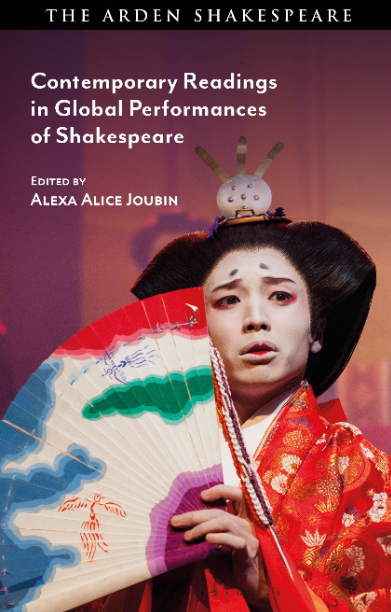Contemporary Readings in Global Performances of Shakespeare
Arden Bloomsbury, 2024 ::: ISBN: 9781350410817
Table of Contents
- The Great Globe Itself: An Introduction to Shakespeare in Heterotopia by Alexa Alice Joubin
Methodologies
- 1. Not What Shakespeare Wrote? A Strategy for Reading Shakespeare in Translation by Daniel Gallimore
- 2. Shakespeare and World Cinema: A Strategy for Reading Film by Mark Thornton Burnett
- 3. Shakespeare and Multilinguistic Affairs: A Strategy for Reading Across Borders by Michael Saenger
- 4. Shakespeare in Turkey: A Strategy for Reading Kaleidoscopic Modernity by Abdulhamit Arvas
Big Pictures
- 5. Shakespeare in Iran, Afghanistan, and the Persian Diaspora by Shauna O’Brien and Ema Vyroubalova
- 6. Shakespeare and Southeast Asia by Kathy Foley
- 7. Shakespeare and Latin America by Anna Stegh Camati and Maria Clara Versiani Galery
- 8. Shakespeare and the Arab World by Katherine Hennessey
- 9. Shakespeare and India by Thea Buckley
- 10. Shakespeare and the Slavic World by Natalia Khomenko
Case Studies
- 11. Haider Revisited: Postcoloniality and the Reception of Shakespeare Adaptations by Amrita Sen
- 12. Korean Shamanic Ritual, Yang Jung-ung’s Hamlet, and Oh Tae-suk’s The Tempest
- 13. Shakespeare as a Role-Playing Game on Zoom: Virtual Theatre in Brazil During and After the Pandemic by Aline de Mello Sanfelici
- 14. Shakespeare and the UK: ‘Brand Britain’ and the British Shakespearean repertoire, 1997-2017 by Stephen Purcell
- 15. Wayne & Shuster’s Shakespearean Slapstick on Canadian Radio and Television
Coda
Focusing on the modern period, Contemporary Readings in Global Performances of Shakespeare employs a site-specific lens to examine global performances of Shakespeare onstage and onscreen.
The book begins with a section on methodologies, with chapters showcasing how to read modernist adaptations, global cinema, multilingual productions, and Shakespeare in translation. The methodologies explored in the Introduction and in this section include comparative cultural studies and inclusive critical methods for the analysis of themes that are highly relevant to events in our contemporary culture life, such as the #MeToo and #BlackLivesMatter movements.
This is followed by a section on “Big Pictures” where chapters guide readers through short histories of adaptations of Shakespeare in Southeast Asia, Latin America, the Arab world, India, Iran, Afghanistan, and the Persian diaspora. These gripping micro-historical narratives about adaptations demonstrate the value of local knowledge by analyzing the relationships between Shakespeare and his modern interlocutors.
The third section, “Case Studies,” features thematically organized studies that demonstrate fruitful application of aforementioned methodologies to the analysis of key global Shakespeare productions, such as Vishal Bhardwaj’s Bollywood film Haider (Hamlet) and a Brazilian interactive, digital production, Though This Be Madness, during the pandemic. The chapters showcase the how of global Shakespeare studies: how do minoritized artists and audiences engage with Shakespeare? How do we analyze the diverse and polyphonic performances with an eye towards equity and social justice?
In conclusion, adaptations of Shakespeare not only create channels between geocultural spaces but also connect different time periods. Cultural globalization opens up national and regional cultures to other aesthetic and political forces and thereby produces multiple, overlapping worlds.
